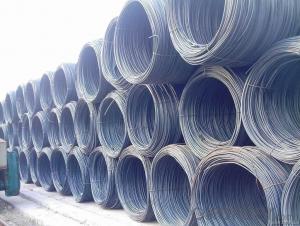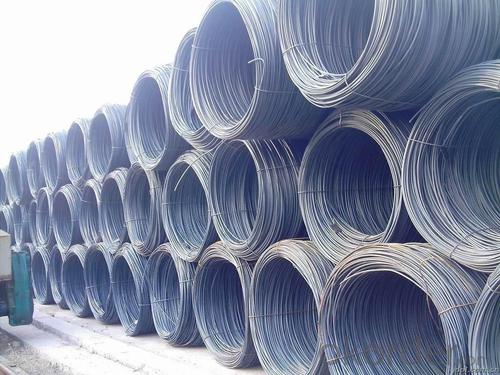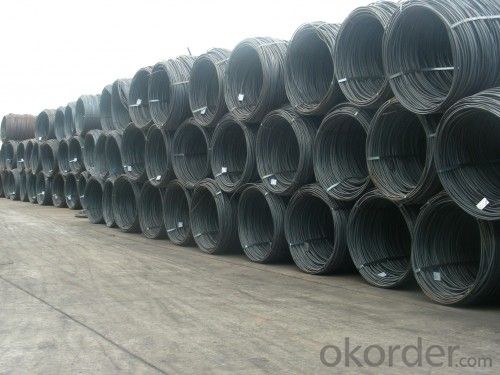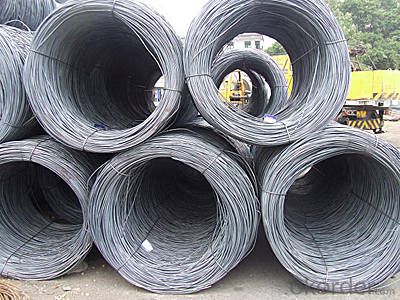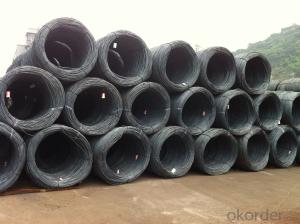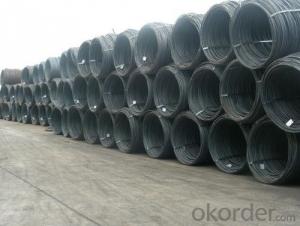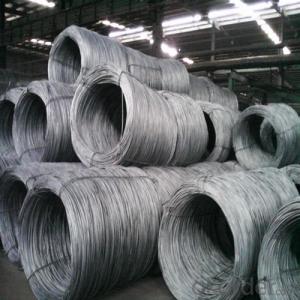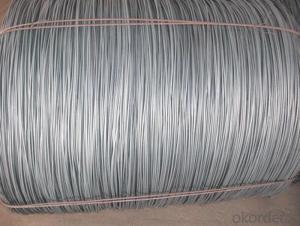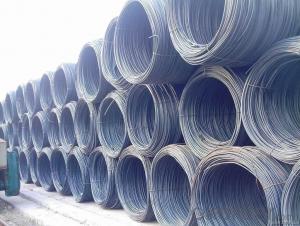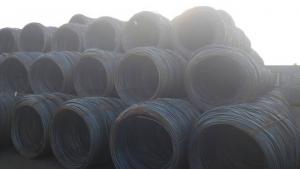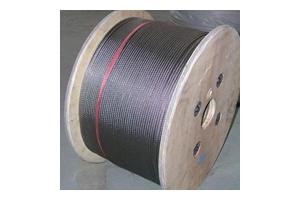Steel Wire Rod with Good Price in Different Materials
- Loading Port:
- Tianjin
- Payment Terms:
- TT or LC
- Min Order Qty:
- 30 m.t.
- Supply Capability:
- 20000 m.t./month
OKorder Service Pledge
OKorder Financial Service
You Might Also Like
Product Description of Steel Wire Rod with Good Price in Different Materials:
OKorder is offeringSteel Wire Rod with Good Price in Different Materials at great prices with worldwide shipping. Our supplier is a world-class manufacturer of steel, with our products utilized the world over. OKorder annually supplies products to African, South American and Asian markets. We provide quotations within 24 hours of receiving an inquiry and guarantee competitive prices.
Product Applications of Steel Wire Rod with Good Price in Different Materials:
Steel Wire Rod with Good Price in Different Materials are ideal for structural applications and are widely used in construction and manufacturing. Carbon steel wire rod is mainly used for reinforcement of reinforced concrete and welded structure or reprocessed (roberts , nail, etc.) materials, especially used to produce wire drawing, welding electrode, nails, spring, electronic, precise machinery parts and so on.
Product Advantages of Steel Wire Rod with Good Price in Different Materials:
OKorder's Steel Wire Rod with Good Price in Different Materials are durable, strong, and wide variety of sizes. They are newly produced by good quality steel billets.
Main Product Features of Steel Wire Rod with Good Price in Different Materials:
· Premium quality
· Prompt delivery & seaworthy packing (30 days after receiving deposit)
· Can be recycled and reused
· Mill test certification
· Professional Service
· Competitive pricing
Product Specifications of Steel Wire Rod with Good Price in Different Materials:
Steel Grade: SAE1006-1018B
Standard: ASTM, GB
Diameter: 5.5mm, 6.5mm, 7mm,8mm,9mm,10mm,12mm,14mm
Type: in coil, coil weight around 2MT
Alloy or Not: Alloy
Technique: Hot Rolled
Place of Origin: China Mainland
Surface: round, no twisted, light and smooth
FAQ of Steel Wire Rod with Good Price in Different Materials:
Q1: Why buy Hot Rolled Low Carbon Steel Wire Rods for Nails, Steel Wire Mesh from OKorder.com?
A1: All products offered byOKorder.com are carefully selected from China's most reliable manufacturing enterprises. Through its ISO certifications, OKorder.com adheres to the highest standards and a commitment to supply chain safety and customer satisfaction.
Q2: How do we guarantee the quality of our products?
A2: We have established an advanced quality management system which conducts strict quality tests at every step, from raw materials to the final product. At the same time, we provide extensive follow-up service assurances as required.
Q3: How soon can we receive the product after purchase?
A3: Within three days of placing an order, we will arrange production. The normal sizes with the normal grade can be produced within one month. The specific shipping date is dependent upon international and government factors, the delivery to international main port about 45-60days.
Pictures of Steel Wire Rod with Good Price in Different Materials

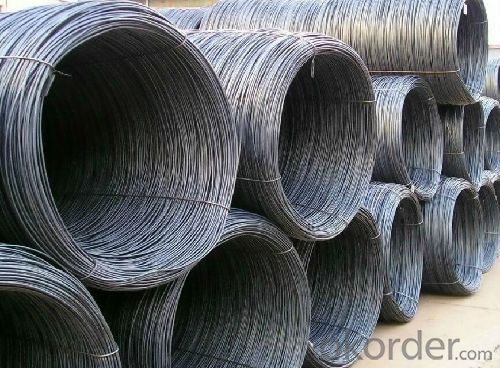
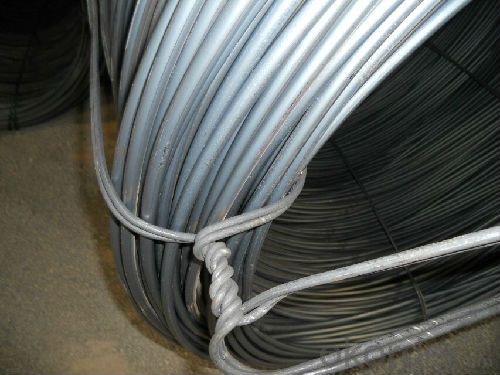
- Q: How is the bending properties of steel wire rod tested?
- The bending properties of steel wire rod are typically tested through a method called the bend test. In this test, a sample of the wire rod is bent to a specific angle or curvature and then examined for any signs of cracking or breaking. The test is conducted by securing one end of the wire rod and applying a force to the other end to bend it. The amount of force required to achieve the desired bend is measured, and the wire rod is visually inspected for any signs of deformation or fracture. Additionally, the test may involve measuring the diameter of the wire rod before and after bending to assess any changes in its physical properties. The bend test provides valuable information about the flexibility and ductility of the steel wire rod, which is crucial in determining its suitability for various applications.
- Q: How are steel wire rods used in the production of wire coat hangers for hanging clothes?
- Steel wire rods are used in the production of wire coat hangers as they serve as the primary material for creating the hanger's structure. The rods are bent and shaped to form the hanger's traditional triangular shape, allowing it to support and hold clothes securely.
- Q: What are the common mechanical properties of steel wire rod?
- The common mechanical properties of steel wire rod include high tensile strength, good ductility, excellent toughness, and high resistance to fatigue.
- Q: What are the major trends in the steel wire rod industry?
- The steel wire rod industry is currently being shaped by several significant trends. Firstly, there is a growing demand for steel wire rods across various industries such as construction, automotive, and manufacturing. This increased demand can be attributed to factors like population growth, urbanization, and global infrastructure development. Secondly, there are notable technological advancements taking place within the industry. These innovations aim to improve manufacturing processes, enhance wire rod quality, and reduce production costs. Automation, robotics, and data analytics are among the key technological trends that are revolutionizing the industry. Additionally, there is a shift towards more sustainable practices in the steel wire rod industry due to increasing environmental concerns. Companies are adopting energy-efficient technologies, reducing emissions, and implementing recycling programs to minimize their environmental impact. This trend is driven by both regulatory requirements and the industry's commitment to sustainability. Furthermore, the industry is experiencing market consolidation, as larger companies acquire smaller players and form strategic partnerships. This consolidation is driven by the need to optimize production capacities, expand global reach, and achieve economies of scale. Mergers and acquisitions are reshaping the competitive landscape of the industry. Lastly, steel wire rod manufacturers are increasingly focusing on product diversification to remain competitive. They are developing a wide range of wire rod products with varying specifications to cater to the diverse needs of different industries. Customization and flexibility in manufacturing are becoming crucial factors for success in the industry. Overall, these trends in the steel wire rod industry are driving it towards a more efficient, sustainable, and customer-centric future.
- Q: What are the different types of steel wire rod annealing atmospheres?
- There are several different types of steel wire rod annealing atmospheres that can be used depending on the desired outcome and specific requirements of the process. These atmospheres can vary in terms of the gases used and the conditions maintained during annealing. 1. Nitrogen Atmosphere: Nitrogen gas is commonly used in steel wire rod annealing processes. It is an inert gas that helps to protect the material from oxidation and decarburization. Nitrogen atmosphere creates a stable environment for annealing, ensuring consistent and controlled heat treatment. 2. Hydrogen Atmosphere: Hydrogen gas is another commonly used annealing atmosphere for steel wire rods. Hydrogen helps to minimize surface oxidation and can also aid in the removal of any surface contaminants or impurities. It promotes a clean and bright surface finish on the wire rod. 3. Vacuum Atmosphere: Vacuum annealing involves creating a low-pressure environment by removing air and other gases from the annealing chamber. This atmosphere prevents oxidation and allows for precise control over the annealing process. Vacuum annealing is often used for high-quality wire rods that require minimal surface defects and improved mechanical properties. 4. Inert Gas Mixtures: In some cases, a mixture of inert gases such as nitrogen and hydrogen may be used as an annealing atmosphere. This combination can provide the benefits of both gases, such as protection against oxidation and impurity removal. The specific mixture and ratios are determined based on the desired outcome and material requirements. 5. Controlled Atmosphere Furnaces: Controlled atmosphere furnaces allow for precise regulation of the annealing atmosphere by continuously monitoring and adjusting the gas composition. This enables the optimization of annealing conditions to achieve desired material properties and surface finishes. It is important to note that the choice of annealing atmosphere depends on the specific steel composition, desired properties, and end-use application of the wire rod. By carefully selecting the appropriate atmosphere, steel wire rods can undergo a controlled heat treatment process that enhances their mechanical properties, surface quality, and overall performance.
- Q: How is steel wire rod used in the production of wire for wire rope slings?
- Steel wire rod is used in the production of wire for wire rope slings by being first drawn through a series of dies to reduce its diameter and increase its length. This process, known as wire drawing, helps to enhance the tensile strength and flexibility of the wire. The resulting wire is then twisted and braided together to form the strands of the wire rope sling, providing it with the necessary strength and durability for lifting heavy loads safely and reliably.
- Q: How is steel wire rod used in the manufacturing of wire for agricultural fencing?
- Steel wire rod is used in the manufacturing of wire for agricultural fencing by being drawn through a series of dies to reduce its diameter and increase its length. This process, known as wire drawing, results in a strong and durable wire that is then woven or welded into the desired fencing shape. The high tensile strength of steel wire rod ensures that the agricultural fencing can withstand the pressure and stress it may encounter in outdoor environments, making it an ideal material for securing livestock and crops.
- Q: Can steel wire rod be used in the production of springs?
- Yes, steel wire rod can be used in the production of springs. Steel wire rod is commonly used due to its high strength and durability, which are essential characteristics for springs that need to withstand repeated stress and maintain their shape over time.
- Q: What are the different types of steel wire rod surface defect prevention and mitigation measures?
- There are various methods to prevent and mitigate surface defects on steel wire rods. Some common measures include implementing proper handling and storage practices, ensuring adequate lubrication during the manufacturing process, utilizing effective cooling techniques, employing surface treatment methods like pickling or phosphating, conducting regular inspections and quality control checks, and implementing corrective actions promptly to address any identified defects. Additionally, proper maintenance of equipment, adherence to industry standards and guidelines, and continuous training and education of personnel are crucial in preventing and mitigating surface defects on steel wire rods.
- Q: What are the common types of steel used for wire rod production?
- The common types of steel used for wire rod production include low carbon steel, high carbon steel, and alloy steel.
Send your message to us
Steel Wire Rod with Good Price in Different Materials
- Loading Port:
- Tianjin
- Payment Terms:
- TT or LC
- Min Order Qty:
- 30 m.t.
- Supply Capability:
- 20000 m.t./month
OKorder Service Pledge
OKorder Financial Service
Similar products
Hot products
Hot Searches
Related keywords
